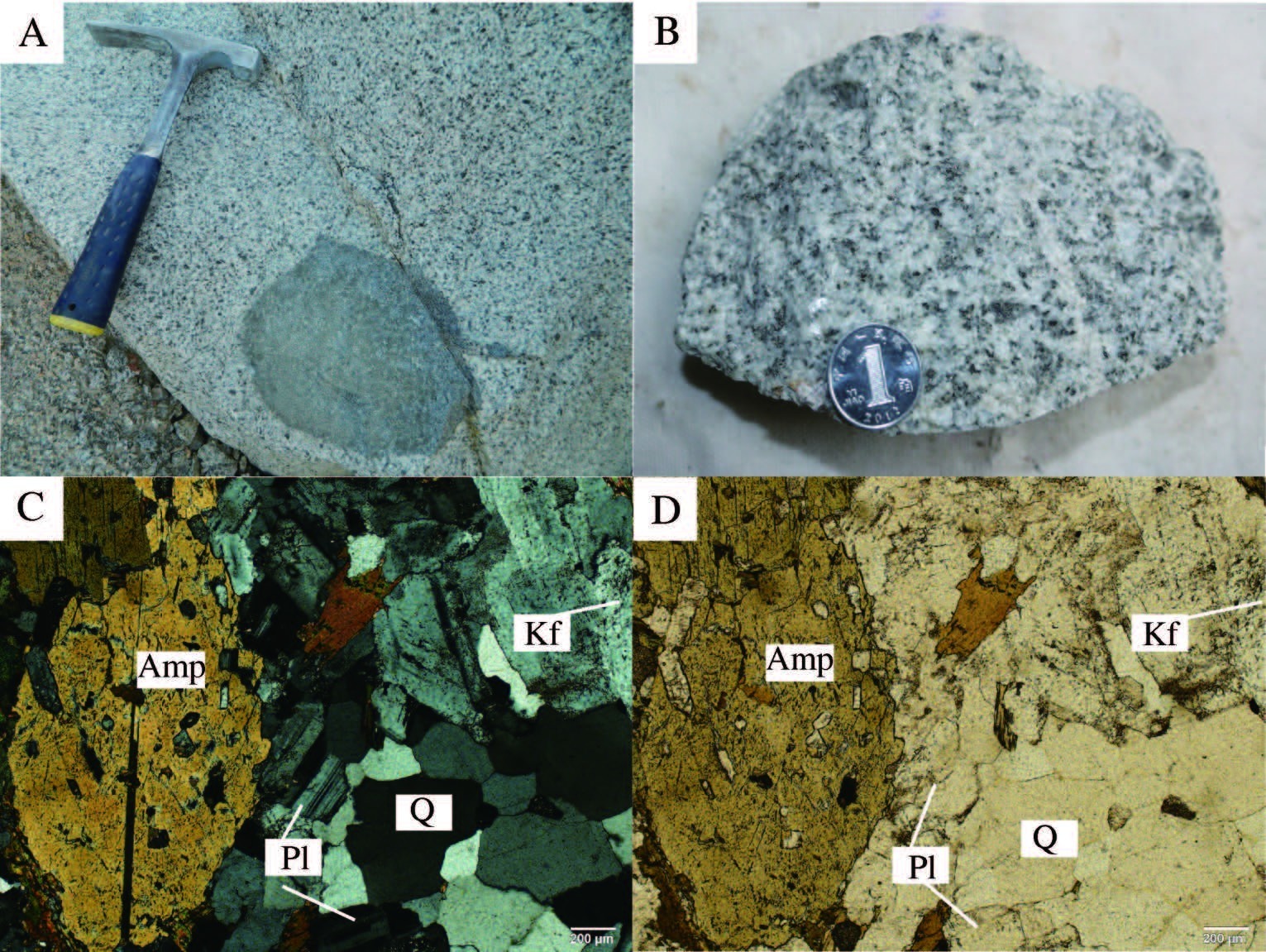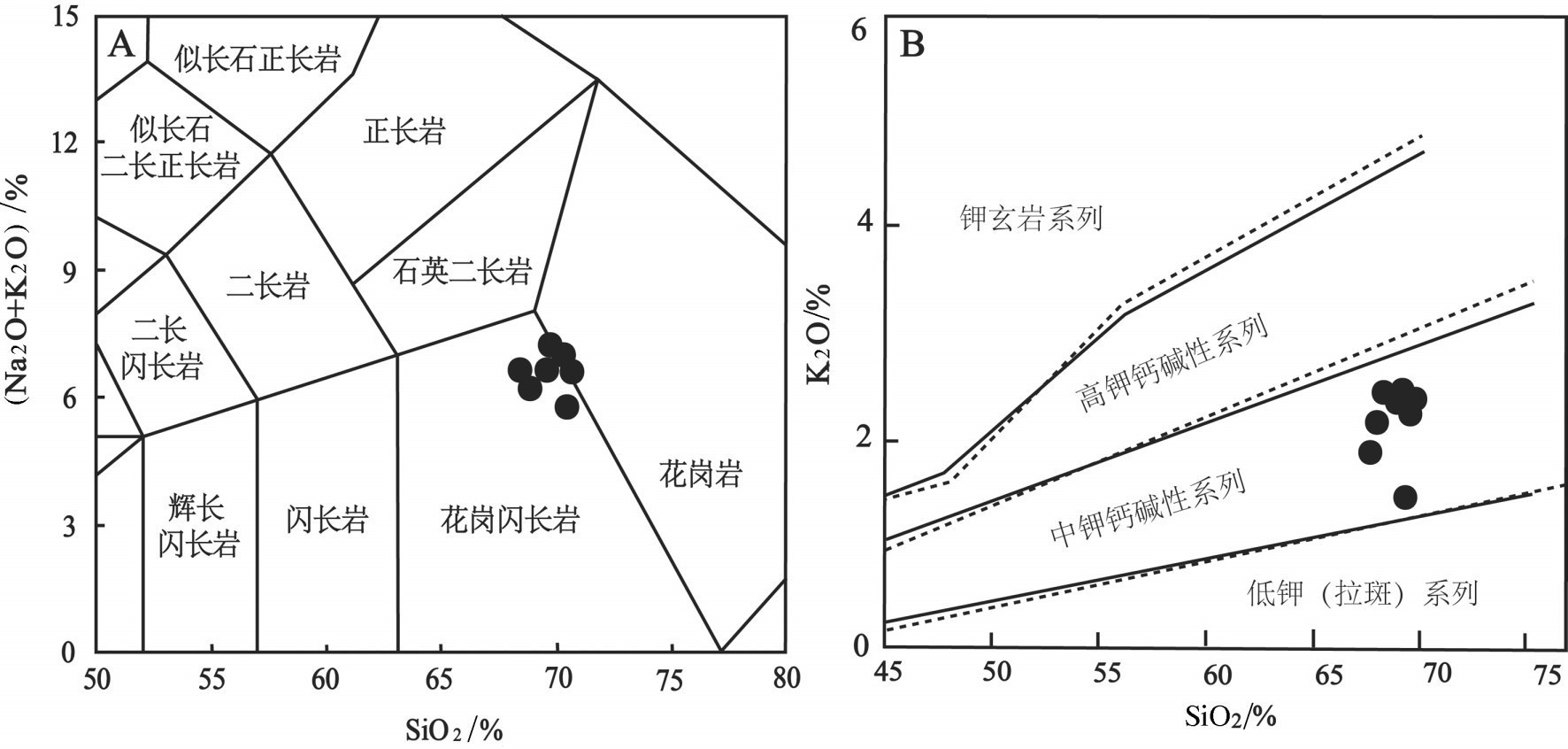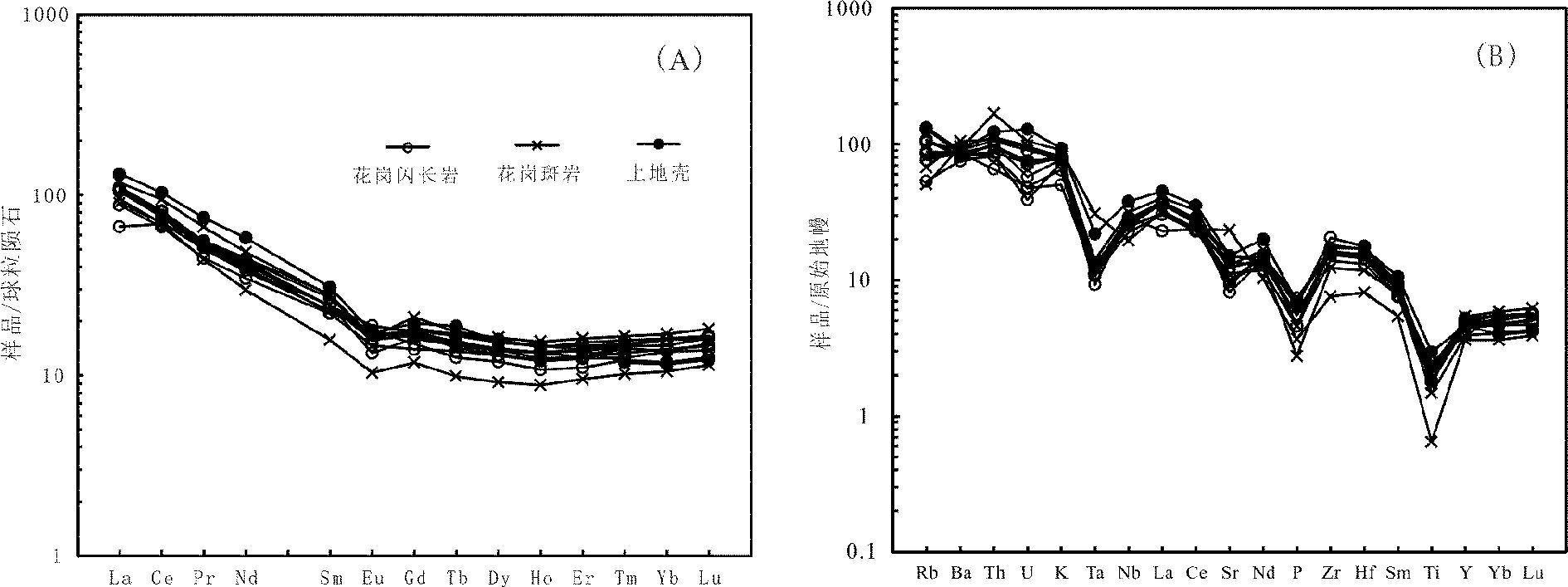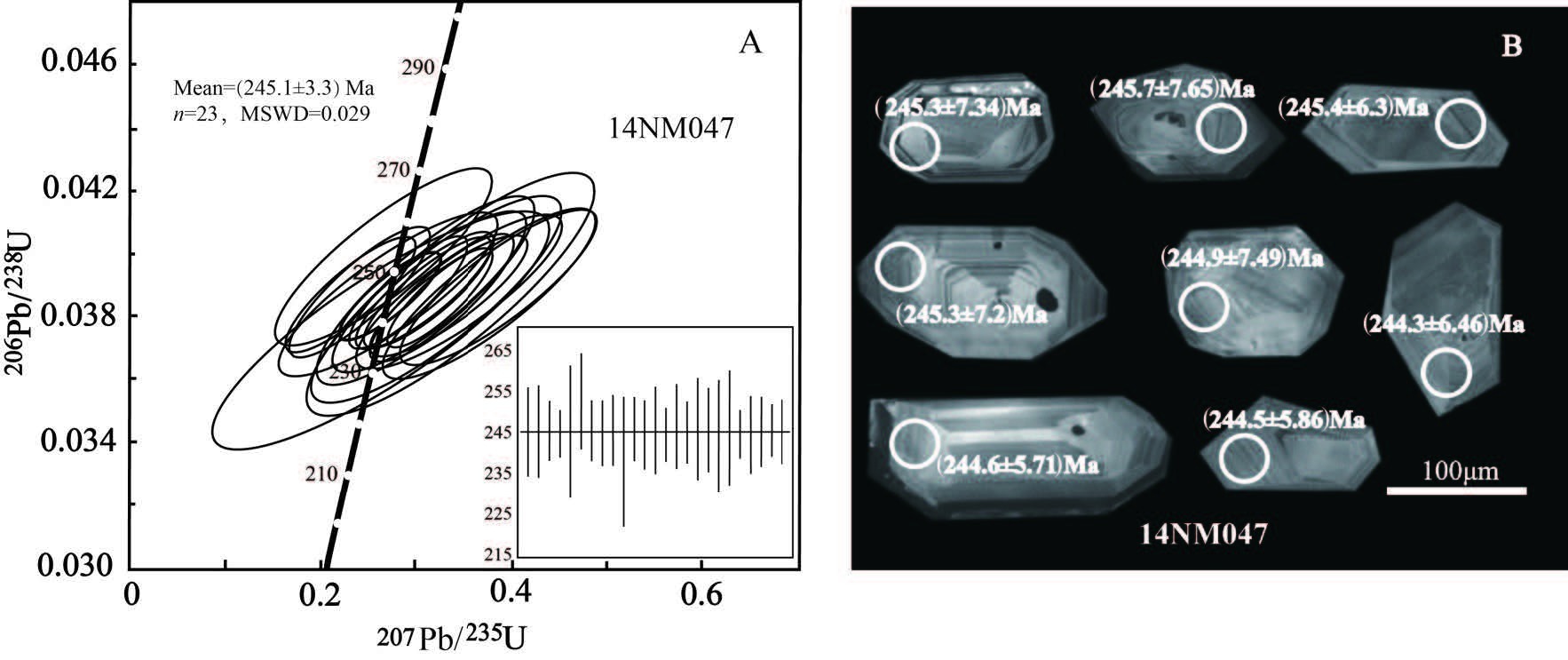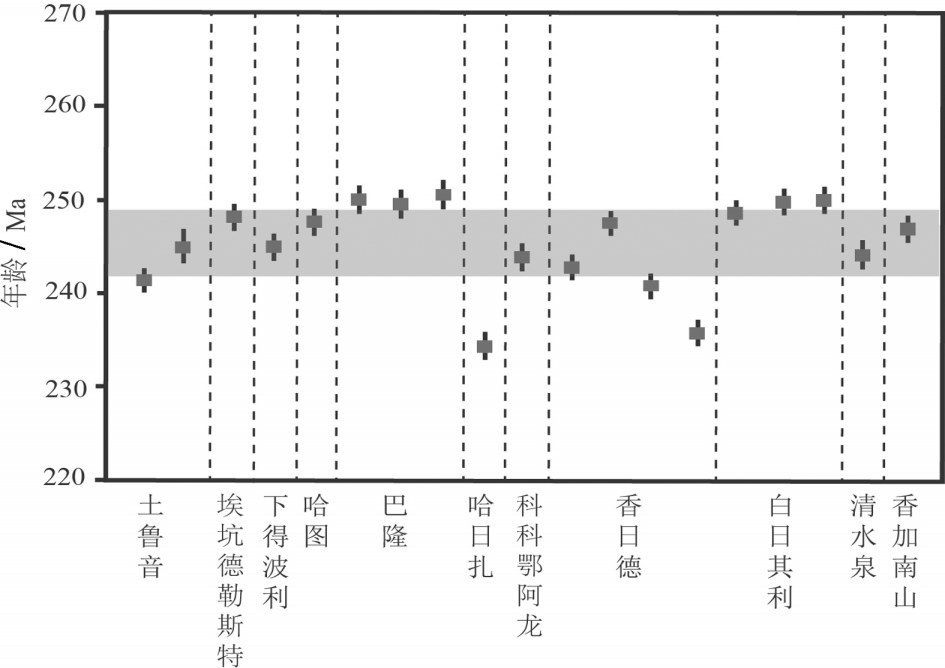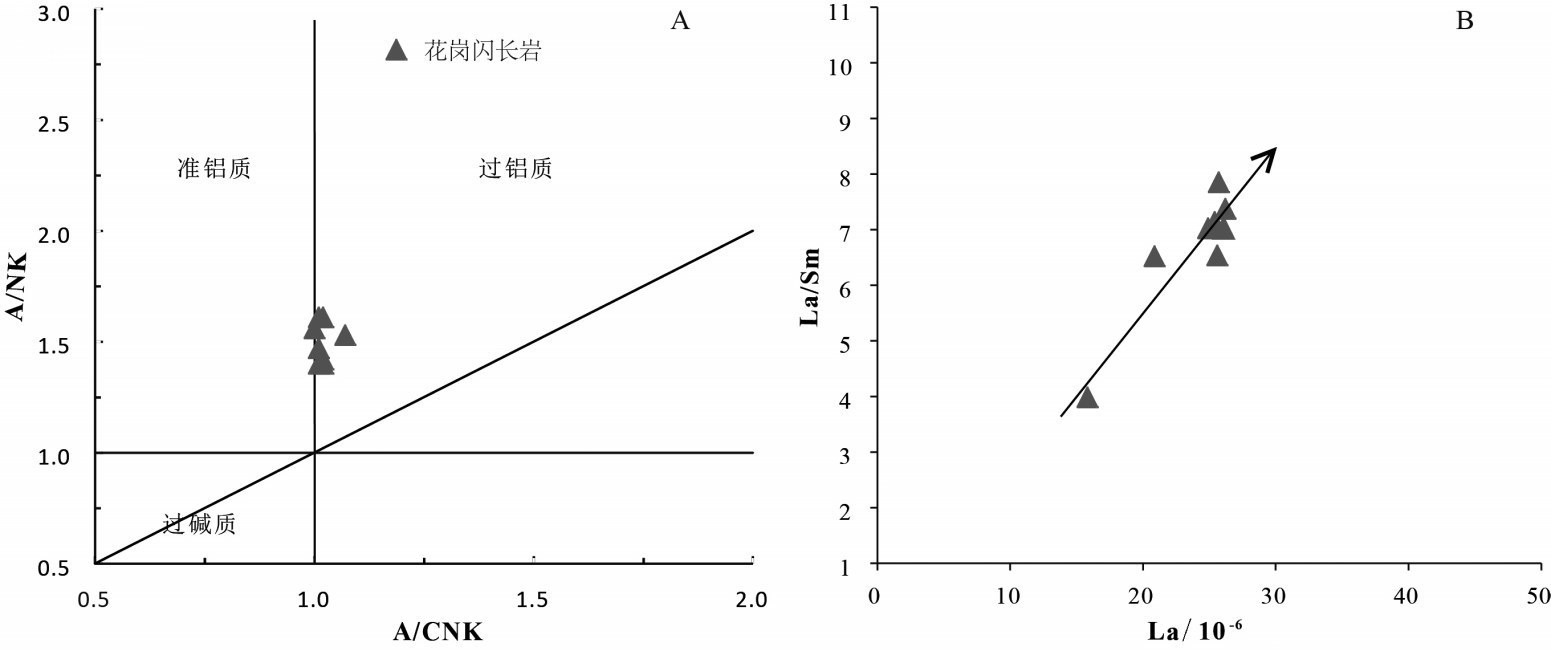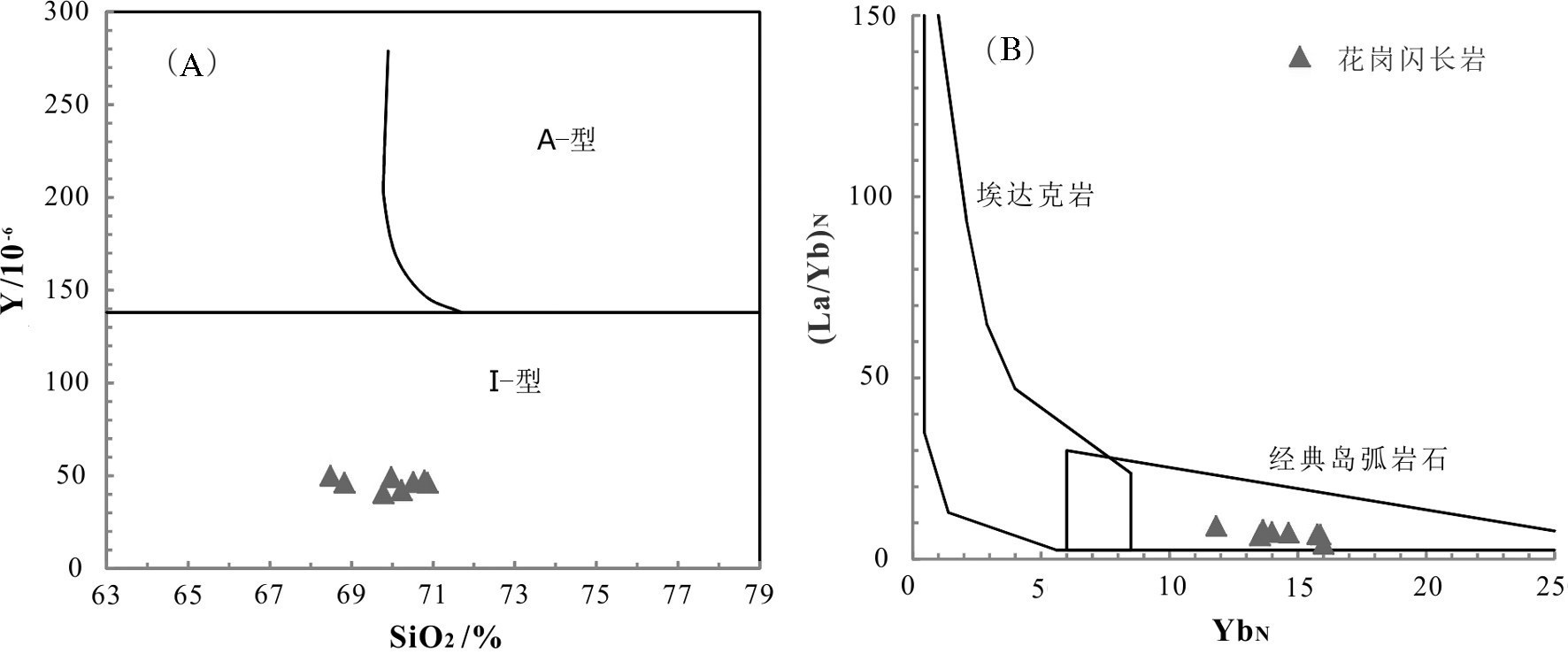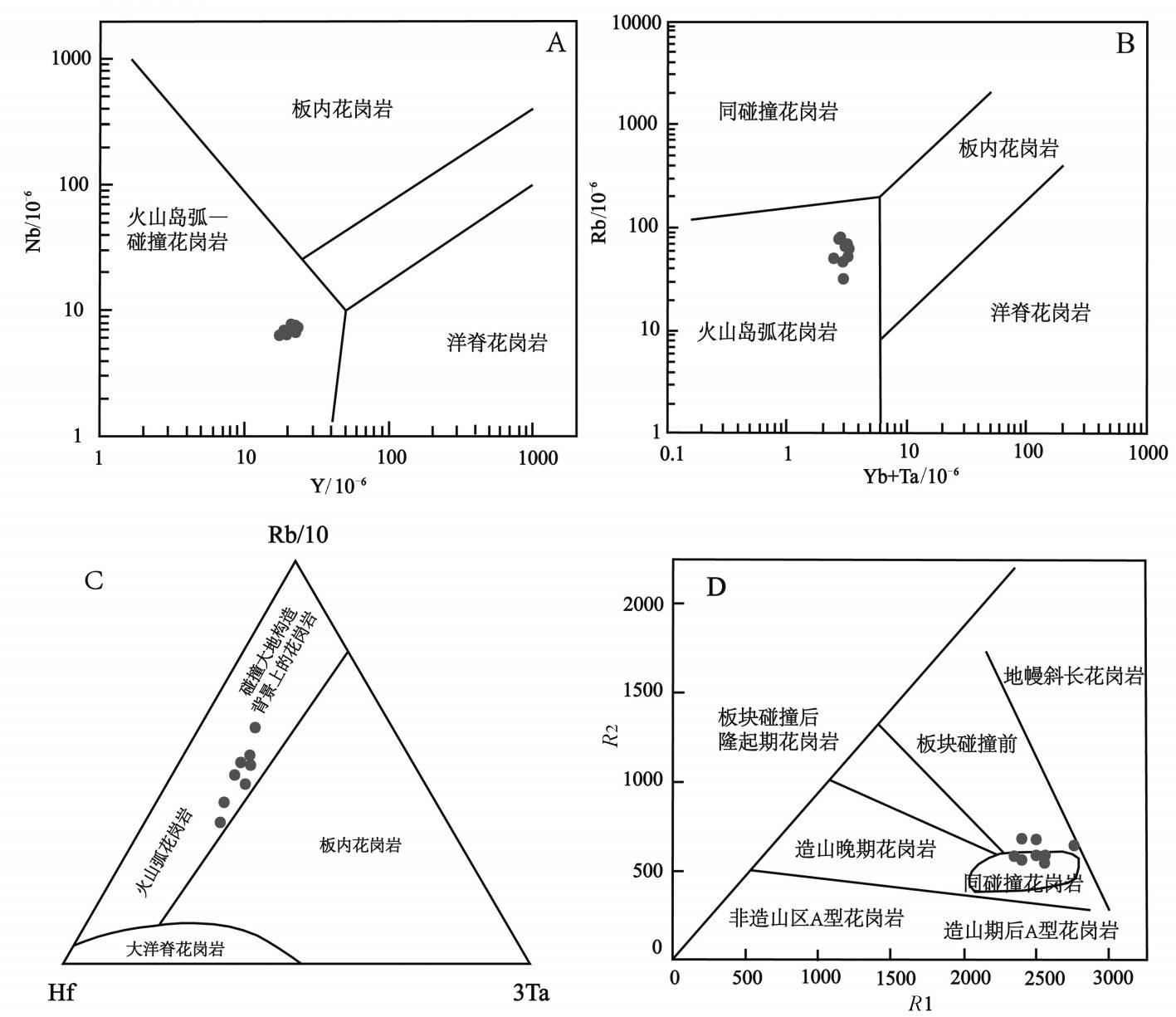Geochemical and zircon U-Pb dating characteristics and significance of the Tuluyin granites in the east of East Kunlun orogenic belt
-
摘要:
岩浆活动在板块构造机制中可以看作是大洋板块俯冲或者大陆板块碰撞等过程所伴随的深部作用响应,也是探索深部作用过程的“岩石探针”。土鲁音岩体位于东昆仑东部,紧邻昆中断裂南部区域。在详细野外调研基础上,主要对土鲁音花岗岩体进行岩石学、地球化学以及年代学的研究。结果显示,土鲁音岩体主要岩性为花岗闪长岩,其SiO2为68.49%~70.87%,全碱含量为5.94%~7.16%,K2O/Na2O比值为0.34~0.57,Mg#值中等(35.92~41.86),A/CNK值(1~1.07)均小于1.1,属弱过铝质钙碱性I型花岗岩。岩体稀土总量较低(118.91×10-6~143.97×10-6),(La/Yb)N为4.17~9.14,具有轻稀土元素富集、重稀土元素平坦分布的特征,弱负Eu异常,且显著亏损Nb、Ta、P、Ti等高场强元素,富集Rb、Ba、Th等大离子亲石元素。锆石LA-ICP-MS U-Pb测年结果显示土鲁音花岗岩体侵位时代(245.1±3.3)Ma,和区域内下得波利、埃坑德勒斯特花岗岩体具有一致的成岩年龄,同属印支早期产物。地球化学特征反映壳源部分熔融成因,并有幔源物质及热流参与,结合区域已有的年代学、地球化学以及地质资料,笔者认为土鲁音岩体形成于阿尼玛卿-古特提斯洋北向俯冲的地球动力学背景。
Abstract:Magmatism is regarded as the deep response to the subduction and collision and also a petroprobe to explore the deep process. The Tuluyin area lies in the east of East Kunlun orogenic belt (EKOB), close to the south of the middle fault of EKOB. Based on detailed field investigation, the authors studied the petrology, geochemistry and geochronology of Tuluyin granitoids. Geochemical composition shows that Tuluyin granitoids are lithologically dominated by granodiorite. The SiO2 varies from 68.49% to 70.87%. The total alkali content is in the range of 5.94%~7.16%, and the K2O/Na2O ratios vary from 0.34 to 0.57. Mg# values are medium in granitoids (35.92-41.86). The A/CNK values (1-1.07) are lower than 1.1, showing that they belong to slightlyperaluminous calc-alkaline I-type granites. The rocks are enriched in light RRE (LRRE) with a flat heavy RRE (HRRE) pattern. There are no or weak negative Eu anomalies. The ratios of (La/Yb)N are in the range of 4.17-9.14, with the total REE content varying from 118.91×10-6 to 143.97×10-6. The rocks are enriched in large ion lithophile elements (Rb, Th, Ba) and depleted in high field strength elements (Nb, Ta, P, Ti). LA-ICP-MS zircon U-Pb dating shows a crystallization age of 245 Ma, identical with the age of Xiadeboli and Aikengdelesite granitoids, suggesting that they all belong to the Early Indosinian period. Geochemical characteristics indicate that these rocks were derived from partial melting of the crust, with the addition of mass and heat flow from the mantle. Based on the existing geochronologic, geochemical and geological data, the authors hold that Tuluyin granitoids were formed under a background of the Anyemaqen-Paleo-Tethys Oceanic crust subducted into EKOB.
-
致谢: 河北地质测绘院帮助对样品进行初步处理,主量元素测试在中国地质大学(北京)科学研究院地球化学实验室进行,微量元素测试在中国地质大学(武汉)地质过程与矿产资源国家重点实验室进行,LA-ICP-MS 锆石U-Pb 定年在中国科学院青藏高原研究所完成;黄慧博士,白洋、曾洋在样品采集与处理方面提供帮助,权瑞、杨洋和李雪峰、潘彦宁、隋真龙和孙转荣在实验及数据处理方面提供帮助,张亮亮博士在数据分析方面提供了建议和启发,评审老师提出良好的修改意见,谨在此向以上单位和个人致以诚挚的谢意。
-
图 4 土鲁音岩体球粒陨石标准化分布型式图(A)和原始地幔标准化蛛网图(B)(球粒陨石及原始地幔数据引自[29];上地壳数据引自[30];花岗斑岩数据引自[31])
Figure 4. Chondrite-normalized REE patterns(A)and primitive mantle normalized trace element spider diagrams(B)(normalization values after reference [29];upper crust data after reference [30]; granite porphyry data after reference [31])of Tuluyin granitoids
表 1 土鲁音花岗岩体主量(%)及微量稀土(10-6)分析数据
Table 1 Chemical compositions (%),REE and trace elements(10-6)of Tuluyin granitoids

表 2 土鲁音花岗岩锆石LA-ICP-MS U-Pb 定年分析数据
Table 2 Data of zircon LA-ICP-MS U-Pb ages of Tuluyin granitoids

-
[1] 莫宣学,赵志丹,邓晋福,等.印度-亚洲大陆主碰撞过程的火山作用响应[J].地学前缘,2003,10(3):135-148. Mo Xuanxue,Zhao Zhidan,Deng Jinfu,et al.Response of volcanism to the India-Asian collision[J].Earth Science Frontiers,2003,10(3):135-148(in Chinese with English abstract).
[2] 殷鸿福,张克信.东昆仑造山带的一些特点[J].地球科学——中国地质大学学报.1997,22(4):339-342. http://www.cnki.com.cn/Article/CJFDTOTAL-DQKX704.000.htm Yin Hongfu,Zhang Kexin.Characteristics of the Eastern Kunlun Orogenic Belt[J].Earth Science:Journal of China University of Geosciences,1997,22(4):339-342(in Chinese with English abstract). http://www.cnki.com.cn/Article/CJFDTOTAL-DQKX704.000.htm
[3] 姜春发,王宗起,李锦轶,等.中央造山带开合构造.北京:地质出版社,2000:1-154. Jiang Chunfa,Wang Zongqi,Li Jinyi.Opening-closing Tectonics of the Central Orogenic Belt[M].Bejing:Geological Publishing House,2000:1-154(in Chinese with English abstract).
[4] 潘桂棠,王立全,朱弟成,等.青藏高原区域地质调查中几个重大科学问题的思考[J].地质通报,2004,23(1):12-19. http://www.cnki.com.cn/Article/CJFDTOTAL-ZQYD200401003.htm Pan Guitang,Wang Liquan,Zhu Dicheng,et al.Thoughts on some important scientific problems in regional geological survey of the Qinghai-Tibet Plateau[J].Geological Bulletin of China,2004,23(1):12-19(in Chinese with English abstract). http://www.cnki.com.cn/Article/CJFDTOTAL-ZQYD200401003.htm
[5] 许志琴,杨经绥,李文昌,等.青藏高原中的古特提斯体制与增生造山作用[J].岩石学报,2013,29(6):1847-1860. http://www.cnki.com.cn/Article/CJFDTOTAL-YSXB201306002.htm Xu Zhiqin,Yang Jingsui,Li Wenchang,et al.Paleo-Tethys system and accretionary orogeny in the Tibet Plateau[J].Acta Petrologica Sinica,2013,29(6):1847-1860(in Chinese with English abstract). http://www.cnki.com.cn/Article/CJFDTOTAL-YSXB201306002.htm
[6] 莫宣学,罗照华,邓晋福,等.东昆仑造山带花岗岩及地壳生长[J].高校地质学报,2007,13(3):403-414. http://www.cnki.com.cn/Article/CJFDTOTAL-GXDX200703005.htm Mo Xuanxue,Luo Zhaohua,Deng Jinfu,et al.Granitoids and crustal growth in the East Kunlun Orogenic Belt[J].Geological Journal of China Universities,2007,13(3):403-414(in Chinese with English abstract). http://www.cnki.com.cn/Article/CJFDTOTAL-GXDX200703005.htm
[7] 罗照华,邓晋福,曹永清,等.青海省东昆仑地区晚古生代-早中生代火山活动与区域构造演化[J].现代地质,1999,13(1):51-56. http://www.cnki.com.cn/Article/CJFDTOTAL-XDDZ901.007.htm Luo Zhaohua,Deng Jinfu,Cao Yongqing,et al.On Late Paleozoic-Early Mesozoic volcanism and regional tectonic evolution of Eastern Kunlun,Qinghai Province[J].Geoscience,1999,13(1):51-56(in Chinese with English abstract). http://www.cnki.com.cn/Article/CJFDTOTAL-XDDZ901.007.htm
[8] 罗照华,柯珊,曹永清,等.东昆仑印支晚期幔源岩浆活动[J].地质通报,2002,21(6):292-97. http://www.cnki.com.cn/Article/CJFDTOTAL-ZQYD200206002.htm Luo Zhaohua,Ke Shan,Cao Yongqing,et al.Late Indosinian mantle-derived magmatism in the East Kunlun[J].Geological Bulletin of China,2002,21(6):292-297(in Chinese with English abstract). http://www.cnki.com.cn/Article/CJFDTOTAL-ZQYD200206002.htm
[9] 袁万明,莫宣学,喻学惠,等.东昆仑印支期区域构造背景的花岗岩记录[J].地质评论,2000,46(2):203-211. http://www.cnki.com.cn/Article/CJFDTOTAL-DZLP200002012.htm Yuan Wanming,Mo Xuanxue,Yu Xuehui,et al.The Record of Indosinian Tectonic Setting from the Granitoid of East Kunlun Mountains[J].Geological Review,2000,46(2):203-221(in Chinese with English abstract). http://www.cnki.com.cn/Article/CJFDTOTAL-DZLP200002012.htm
[10] Huang H,Niu Y L,Geoff Nowell.Geochemical constraints on the petrogenesis of granitoids in the East Kunlun Orogenic belt,northern Tibetan Plateau:Implications for continental crust growth through syn-collisional felsic magmatism[J].Chemical Geology,2014,370:1-18. doi: 10.1016/j.chemgeo.2014.01.010
[11] 郭正府,邓晋福,许志琴,等.青藏东昆仑晚古生代-中生代中酸性火成岩与陆内造山过程[J].现代地质,1998,12(3):344-352. http://www.cnki.com.cn/Article/CJFDTOTAL-XDDZ803.006.htm Guo Zhengfu,Deng Jinfu,Xu Zhiqin,et al.Late Paleozoic-Mesozoic intracontinental orogenic process and intermediate acidic igneous rocks from the Eastern Kunlun Mountains of North western China[J].Geoscience,1998,12(3):344-352(in Chinese with English abstract). http://www.cnki.com.cn/Article/CJFDTOTAL-XDDZ803.006.htm
[12] 陈国超,裴先治,李瑞保,等.东昆仑洪水川地区科科鄂阿龙岩体锆石U-Pb年代学、地球化学及其地质意义[J].地质学报.2013,87(2):178-196. http://www.cnki.com.cn/Article/CJFDTOTAL-DZXE201302006.htm Chen Guochao,Pei Xianzhi,Li Ruibao,et al.Geochronology and Genesis of the Helegang Xilikete Granitic Plutons from the Southern Margin of the Eastern East Kunlun Orogenic Belt and Their Tectonic Significance[J].Acta Geologica Sinica,2013,87(10):178-196(in Chinese with English abstract). http://www.cnki.com.cn/Article/CJFDTOTAL-DZXE201302006.htm
[13] 熊富浩,马昌前,张金阳,等.东昆仑造山带早古生代镁铁质岩墙群LA-ICP-MS锆石U-Pb定年、元素和Sr-Nd-Hf同位素地球化学[J].岩石学报,2011,27(11):3350-3364. http://www.cnki.com.cn/Article/CJFDTOTAL-YSXB201111016.htm Xiong Fuhao,Ma Changqian,Zhang Jinyang,et al.LA-ICPMS zircon U-Pb dating,elements and Sr-Nd-Hf isotope geochemistry of the Early Mesozoic mafic dyke swarms in East Kunlun Orogenic Belt[J].Acta Petrologica Sinica,2011,27(11):3350-3364(in Chinese with English abstract). http://www.cnki.com.cn/Article/CJFDTOTAL-YSXB201111016.htm
[14] 熊富浩.东昆仑造山带东段古特提斯域花岗岩类时空分布-岩石成因及其地质意义[D].博士学位论文,2014:22-74. http://cdmd.cnki.com.cn/article/cdmd-10491-1014340842.htm Xiong Fuhao.Spatial-temporal Pattern,Petrogenesis and Geological Implications of Paleo-Tethyan Granitoids in the East Kunlun Orogenic Belt (Eastern Segment)[D].Wuhan:China University of Geoscience,2014,22-74(in Chinese with English abstract). http://cdmd.cnki.com.cn/article/cdmd-10491-1014340842.htm
[15] 罗明飞,莫宣学,喻学惠,等.东昆仑香日德地区晚三叠世花岗岩LA-ICP-MS锆石定年、岩石成因和构造意义[J].岩石学报,2014,30(11):3229-3241. http://www.cnki.com.cn/Article/CJFDTOTAL-YSXB201411010.htm Luo Mingfei,Mo Xuanxue,Yu Xuehui,et al.Zircon LA-ICPMS U-Pb age dating,petrogenesis and tectonic implications of the Late Triassic granites from the Xiangride area,East Kunlun[J].Acta Petrologica Sinica,2014,30(11):3229-3241(in Chinese with English abstract). http://www.cnki.com.cn/Article/CJFDTOTAL-YSXB201411010.htm
[16] Liu H.Petrology,geochemistry and geochronology of late Triassic volcanics,Kunlun orogenic belt,western China:Implications for tectonic setting and petrogenesis[J].Geochemical Journal,2005,39(1):1-20. doi: 10.2343/geochemj.39.1
[17] Yuan C,Sun M,Xiao W J,et al.Garnet-bearing tonalitic porphyry from East Kunlun,Northeast Tibetan Plateau:implications for adakite and magmas from the MASH zone.International[J].Journal of Earth Sciences,2009,98(6):1489-1510. doi: 10.1007/s00531-008-0335-y
[18] Wang Q,Li Z X,Chung S L,et al.Late Triassic high-Mg andesite/dacite suites from northern Hohxil,North Tibet:Geochronology,geochemical characteristics,petrogenetic processes and tectonic implications[J].Lithos,2011,126(1/2):54-67. http://cn.bing.com/academic/profile?id=2045538797&encoded=0&v=paper_preview&mkt=zh-cn
[19] 王国灿,贾春兴,朱云海,等.中华人民共和国区域地质调查报告:阿拉克湖幅(I47C001001),1:250000[R].武汉:中国地质大学出版社,2004:1-419. Wang Guocan,Jia Chunxing,Zhu Yunhai,et al.The People's Republic of China Regional Geological Report:Alake Hu Map (I47C001001),Scale:1:250000[R].Wuhan:China University of Geosciences Press,2004:1-419(in Chinese).
[20] 王国灿,王青海,简平,等.东昆仑前寒武基底变质岩系的锆石SHRIMP年龄及其构造意义[J].地学前缘,2004,11(4):481-490. http://www.cnki.com.cn/Article/CJFDTOTAL-DXQY200404019.htm Wang Guocan,Wang Qinghai,Jian Ping,et al.Zircon SHRIMP ages of Precambrian metamorphic basement rocks and their tectonic significance in the eastern Kunlun Moutains,Qinghai Province,China[J].Earth Science Frontiers,2004,11(4):481-490(in Chinese with English abstract). http://www.cnki.com.cn/Article/CJFDTOTAL-DXQY200404019.htm
[21] 李怀坤,耿建珍,郝爽,等.用激光烧蚀多接收器等离子体质谱仪(LA-ICP-MS)测定锆石U-Pb同位素年龄的研究[J].矿物学报,2009,29(增刊):600-601. http://www.cnki.com.cn/Article/CJFDTOTAL-KWXB2009S1311.htm Li Huaikun,Geng Jianzhen,Hao Shuang,et al.Study on zircon U-Pb dating by LA-ICP-MS[J].Acta Mineralogical Sinica,2009,29(supp.):600-601(in Chinese with English abstract). http://www.cnki.com.cn/Article/CJFDTOTAL-KWXB2009S1311.htm
[22] Gao S,Liu X M,Yuan H L,et al.Determination of forty-two major and trace element in USGS and NIST SRM glasses by laser ablation-inductively coupled plasma-Mass Spectrometry[J].Geostandards Newsletter-Journal of Geostandards and Geoanalysis,2002,26(2):191-196. http://cn.bing.com/academic/profile?id=2068226577&encoded=0&v=paper_preview&mkt=zh-cn
[23] Andersen T.Correcyion of common lead in U-Pb analyses that do not report 204Pb[J].Chemical Geology,2002,192(1/2):59-79.
[24] 李怀坤,朱士兴,相振群,等.北京延庆高于庄组凝灰岩的锆石U-Pb定年研究及其对华北北部中元古界划分新方案的进一步约束[J].岩石学报,2010,26(7):2131-2140. http://www.cnki.com.cn/Article/CJFDTOTAL-YSXB201007016.htm Li Huaikun,Zhu Shixing,Xiang Zhenqun,et al.Zircon U-Pb dating on tuff bed from Gaoyuzhuang Formation in Yanqing,Beijing:Further constraints on the new subdivision of the Mesoproterozoic stratigraphy in the northern North China Craton[J].Acta Petrologica Sinica,2010,26(7):2131-2140(in Chinese with English abstract). http://www.cnki.com.cn/Article/CJFDTOTAL-YSXB201007016.htm
[25] Eric A K M.Naming materials in the magma/igneous rock system[J].Earth Science Reviews,1994,37:215-224. doi: 10.1016/0012-8252(94)90029-9
[26] Peccerillor R.Geochemistry of Eocene calc-alkaline volcanic rocks from the Kastamonu area,Northern Turkey[J].Contribution of Mineral Petrology,1976,58:63-81. doi: 10.1007/BF00384745
[27] Middlemost,et al.Magmas and Magmatic Rocks[M].London:Longman,1985:1-266.
[28] 赵振华,熊小林,王强,等.铌与钽的某些地球化学问题[J].地球化学,2008,37(4):304-320. http://www.cnki.com.cn/Article/CJFDTOTAL-DQHX200804004.htm Zhao Zhenhua,Xiong Xiaolin,Wang Qiang,et al.Some aspects on geochemistry of Nb and Ta[J].Geochimica,2008,37(4):304-320(in Chinese with English abstract) http://www.cnki.com.cn/Article/CJFDTOTAL-DQHX200804004.htm
[29] Sun S S,McDonough W.Chemical and isotopic systematics of oceanic basalts:implications for mantle composition and processes[J].Geological Society London Special Publications,1989,42:313-345. doi: 10.1144/GSL.SP.1989.042.01.19
[30] RL Rudnick,S Gao.Composition of the Continental[J].Crust-Treatise on Geochemistry,2003,60(1):1-64.
[31] 刘建楠,丰成友,亓锋,等.青海都兰县下得波利铜钼矿区锆石U-Pb测年及流体包裹体研究[J].岩石学报,2012,28(2):679-690. http://www.cnki.com.cn/Article/CJFDTOTAL-YSXB201202026.htm Liu Jiannan,Feng Chengyou,Qi Feng,et al.SIMS zircon U-Pb dating and fluid inclusion studies of Xiadeboli Cu-Mo are district in Dulan County,Qinghai Province,China[J].Acta Petrologica Sinica,2012,28(2):679-690(in Chinese with English abstract). http://www.cnki.com.cn/Article/CJFDTOTAL-YSXB201202026.htm
[32] 熊富浩,马昌前,张金阳,等.东昆仑造山带白日其利辉长岩体LA-ICP-MS锆石U-Pb年龄及其地质意义[J].地质通报,2011,30(8):1196-1202(in Chinese with English abstract). http://www.cnki.com.cn/Article/CJFDTOTAL-ZQYD201108003.htm Xiong Fuhao,Ma Changqian,Zhang Jinyang,et al.Zircon LAICP-MS U-Pb dating of Bairiqili gabbro pluton in the East Kunlun Orogenic Belt and its geological significance[J].Geological Bulletin of China,2011,30(8):1196-1202(in Chinese with English abstract). http://www.cnki.com.cn/Article/CJFDTOTAL-ZQYD201108003.htm
[33] 宋忠宝,张雨莲,陈向阳,等.东昆仑扎日哈含矿花岗闪长斑岩LA-ICP-MS锆石U-Pb定年及地质意义[J].矿床地质,2013,32(1):157-168. http://www.cnki.com.cn/Article/CJFDTOTAL-KCDZ201301014.htm Song Zhongbao,Zhang Yulian,Chen Xiangyang,et al.Geochemical characteristic of Harizha granite diorite-porphyry in East Kunlun and their geological implications[J].Mineral Deposits,2013,32(1):157-168(in Chinese with English abstract). http://www.cnki.com.cn/Article/CJFDTOTAL-KCDZ201301014.htm
[34] 许庆林.青海东昆仑造山带斑岩型矿床成矿作用研究[M].长春:吉林大学,2014,117-145. Xu Qinglin.Study on Metallogenesis of Porphyry Deposits in Eastern Kunlun Orogenic Belt,Qinghai Province[M].Changchun:Jilin University,2014,117-145(in Chinese with English abstract).
[35] 杨延乾.青海东昆仑埃坑得勒斯特钼(铜)矿矿床地质特征及成因探讨[J]长春:吉林大学,2013,26-53. Yang Yanqian.Sduty on Geological Characteristics and Genesis of Aikengdelesite Molybdenum (Copper) Deposit,Eastern Kunlun,Qinghai Province[J]Changchun:Jilin University,2013,26-53(in Chinese with English abstract).
[36] 张旗,王焰,李承东,等.花岗岩的Sr-Yb分类及其地质意义[J].岩石学报,2006,22(9):2249-2269. http://www.cnki.com.cn/Article/CJFDTOTAL-YSXB200609000.htm Zhang Qi,Wang Yan,Li Chengdong,et al.Granite classification on the basis of Sr and Yb contents and its implications[J].Acta Petrologica Sinica,2006,22(9):2249-2269(in Chinese with English abstract). http://www.cnki.com.cn/Article/CJFDTOTAL-YSXB200609000.htm
[37] Foley S F,Peccerillo A.Potassic and ultrapotassic magmas and their origin[J].Lithos,1992,28:181-185. doi: 10.1016/0024-4937(92)90005-J
[38] Dungan M A,Lindstrom M M,McMillan N J,et al.Open system magmatic evolution of Taos Plateau volcanic field,northern New Mexico:1.The Petrology and geochemistry of the servilleta Basalt[J].Journal of Geophysical Research:Solid Earth (1978-2012),1986,91(B6):5999-6028. doi: 10.1029/JB091iB06p05999
[39] Whalen J B,et al.A type granites:geochemical characteristics,discrimination and petrogenesis[J].Contrib.Mineral.Petrol.,1987,95. http://cn.bing.com/academic/profile?id=1977650828&encoded=0&v=paper_preview&mkt=zh-cn
[40] Defant M J,Drummond M S.Derivation of some modern arc magmas by melting of young subduction lithosphere[J].Nature,1990,662-665. http://cn.bing.com/academic/profile?id=1979705656&encoded=0&v=paper_preview&mkt=zh-cn
[41] 谌宏伟,罗照华,莫宣学,等.东昆仑造山带三叠纪岩浆混合成因花岗岩的岩浆底侵作用机制[J].中国地质,2005,32(3):386-394(in Chinese with English abstract). http://geochina.cgs.gov.cn/ch/reader/view_abstract.aspx?file_no=20050306&flag=1 Chen Hongwei,Luo Zhaohua,Mo Xuanxue,et al.Underplating mechanism of Triassic granite of magma mixing origin in the East Kunlun Orogenic Belt[J].Geology in China,2005,32(3):386-394. http://geochina.cgs.gov.cn/ch/reader/view_abstract.aspx?file_no=20050306&flag=1
[42] 刘成东,莫宣学,罗照华,等.东昆仑壳-幔岩浆混合作用:来自锆石SHRIMP年代学的证据[J].科学通报,2004,49(6):596-602(in Chinese with English abstract). http://www.cnki.com.cn/Article/CJFDTOTAL-KXTB200406018.htm Liu Chengdong,Mo Xuanxue,Luo Zhaohua,et al.Mixing events between the crust and mantle-derived magmas in the Eastern Kunlun:Evidence from zircon SHRIMP chronology[J].Chinese Science Bulletin,2004,49(6):596-602(in Chinese with English abstract). http://www.cnki.com.cn/Article/CJFDTOTAL-KXTB200406018.htm
[43] 王秉璋, 罗照华, 李怀毅, 等.东昆仑祁漫塔格走廊域晚古生代—早中生代侵入岩岩石组合及时空格架[J].中国地质, 2009,36(4): 769-782. http://geochina.cgs.gov.cn/ch/reader/view_abstract.aspx?file_no=20090403&flag=1 Wang Bingzhang, Luo Zhaohua, Li Huaiyi, et al. Petrotectonic assemblages and temporal-spatial framework of the Late Paleozoic-Early Mesozoic intrusions in the Qimantage Corridor of the East Kunlun Belt[J].Geology in China, 2009, 36(4): 769-782 (in Chinese with English abstract). http://geochina.cgs.gov.cn/ch/reader/view_abstract.aspx?file_no=20090403&flag=1
[44] 李瑞保, 裴先治, 李佐臣, 等.东昆仑东段晚古生代—中生代若干不整合面特征及其对重大构造事件的响应[J].地学前缘,2012, 19(5): 244-254 (in Chinese with English abstract). http://www.cnki.com.cn/Article/CJFDTOTAL-DXQY201205025.htm Li Ruibao, Pei Xianzhi, Li Zuochen, et al. Geological characteristics of Late Paleozoic-Mesozoic unconformities and their response to some significant tectonic events in eastern part of Eastern Kunlun[J].Earth Science Frontiers, 2012, 19(5): 244-254 (in Chinese with English abstract). http://www.cnki.com.cn/Article/CJFDTOTAL-DXQY201205025.htm
[45] 胡楠, 裴先治, 李瑞保, 等.东昆仑南缘布青山得力斯坦地区马儿争组无缘分析及其构造背景研究[J].地质学报, 2013, 87(11): 1731-1747. http://www.cnki.com.cn/Article/CJFDTOTAL-DZXE201311008.htm Hu Nan, Pei Xianzhi, Li Ruibao, et al.Provenance and Tectonic Setting Study of the Maerzheng Formation at the Delishan of Buqingshan Area in the Southern Margin of East Kunlun[J]. Acta Geologica Sinica, 2013, 87(11): 1731-1747 (in Chinese with English abstract). http://www.cnki.com.cn/Article/CJFDTOTAL-DZXE201311008.htm
[46] Pearce J A, Harris N B W, Tindle A G. Trace element discrimination diagrams for the tectonic interpretation of granitic rocks [J]. Journal of Petrology, 1984, 25(4): 956-983. doi: 10.1093/petrology/25.4.956
[47] Batchelor R A and Bowden P. Petrogenetic interpretation of granitoid rock series using multicationic parameters [J]. Chemical Gology, 1985, 48(1/4): 43-45. http://cn.bing.com/academic/profile?id=2019409833&encoded=0&v=paper_preview&mkt=zh-cn
-
期刊类型引用(11)
1. Jian-yu Liu,Hong-feng Nie,Liang Xu,Chun-lei Xiao,Wei Li,Guo-li Yuan,Yan-peng Huang,Xin-yang Ji,Tian-qi Li. Assessment of ecological geological vulnerability in Mu Us Sandy Land based on GIS and suggestions of ecological protection and restoration. China Geology. 2025(01): 117-143 .  必应学术
必应学术
2. 祝晓松,裴小龙,王伟,张中跃,孙伟涛,倪舒博,公为鑫. 山丘区地表基质空间异质性特征及其对植被生态影响. 地质通报. 2024(09): 1544-1554 .  百度学术
百度学术
3. 刘洪,李文昌,欧阳渊,张景华,张腾蛟,李佑国,黄瀚霄,黄勇,李富,陈敏华,李樋,吴君毅. 基于地质建造的西南山区生态地质编图探索与实践——以邛海—泸山地区为例. 地质学报. 2023(02): 623-638 .  百度学术
百度学术
4. 息朝庄,吴林锋,张鹏飞,杨茗钛,范云飞,夏浩东,邓会娟. 贵州省惠水土壤-灌溉水-雨水-大气降尘中Cd、As等微量元素特征及来源讨论. 中国地质. 2023(01): 192-205 .  本站查看
本站查看
5. 王东晓,袁德志. 锶在土壤-作物中迁移富集机制及作物富锶标准探讨:以河南固始史河一带为例. 现代地质. 2023(03): 767-777 .  百度学术
百度学术
6. 唐智明. 水肥一体化技术及其在柑橘种植上的应用. 现代农业科技. 2022(01): 73-75 .  百度学术
百度学术
7. 习文勇,傅佩红. 基于模糊数学的柑橘种植土地适宜性评价. 浙江农业学报. 2022(01): 141-152 .  百度学术
百度学术
8. 张哲寰,杨佳佳,宋运红,贺鹏飞. 黑龙江省讷河市土壤质量与绿色产地适宜性评价. 地质与资源. 2022(02): 183-192 .  百度学术
百度学术
9. 贾磊,刘洪,欧阳渊,张伟,窦磊,刘子宁,莫滨,陈恩,张腾蛟. 基于地质建造的南方山地-丘陵区地表基质填图单元划分方案——以珠三角新会—台山地区为例. 西北地质. 2022(04): 140-157 .  百度学术
百度学术
10. 李海山. 柑橘种植与机械化节水灌溉技术探讨. 农业开发与装备. 2021(10): 225-226 .  百度学术
百度学术
11. 欧阳渊,张景华,刘洪,黄瀚霄,张腾蛟,黄勇. 基于地质建造的西南山区成土母质分类方案——以大凉山区为例. 中国地质调查. 2021(06): 50-62 .  百度学术
百度学术
其他类型引用(4)



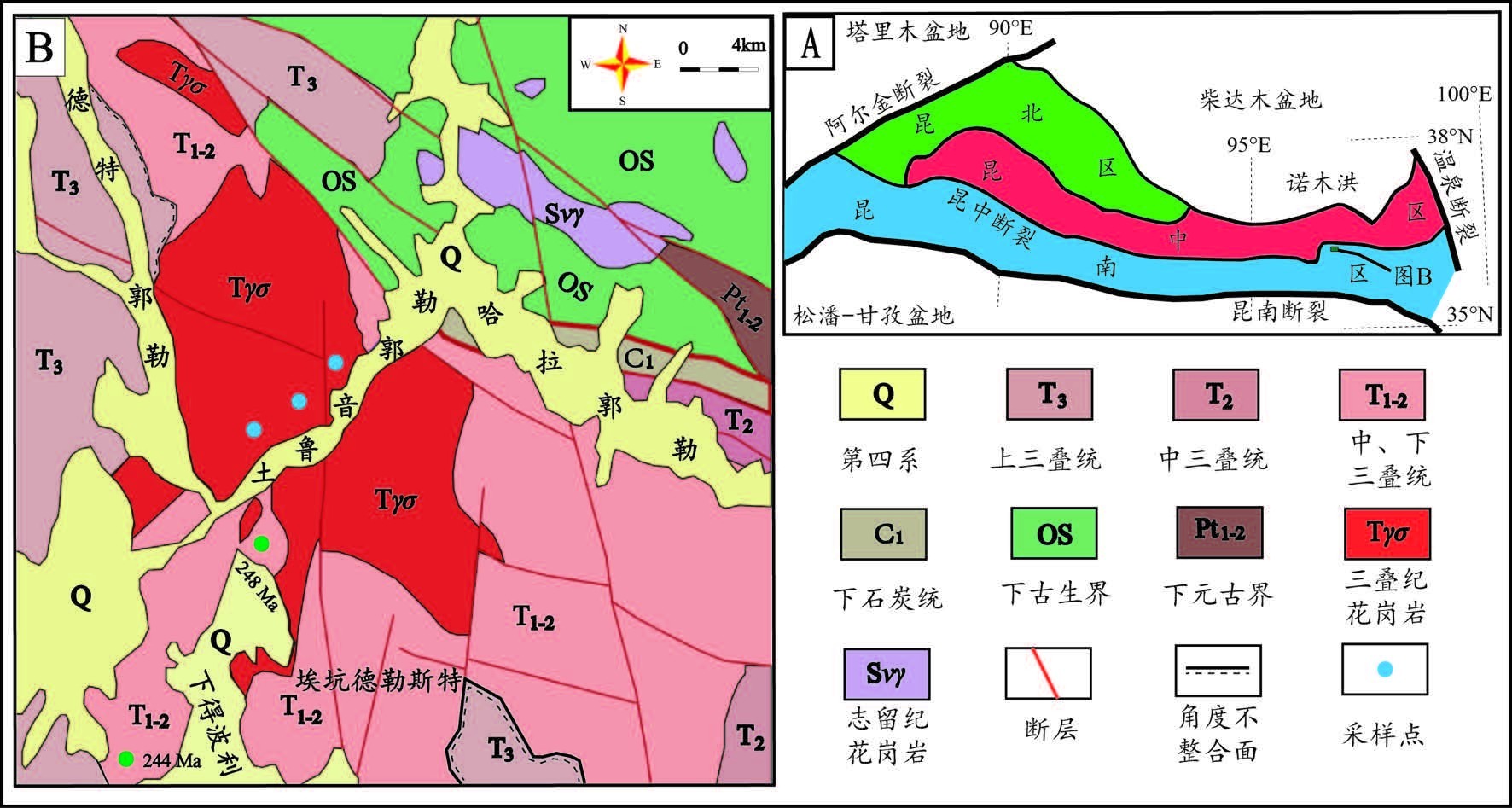
 下载:
下载:
